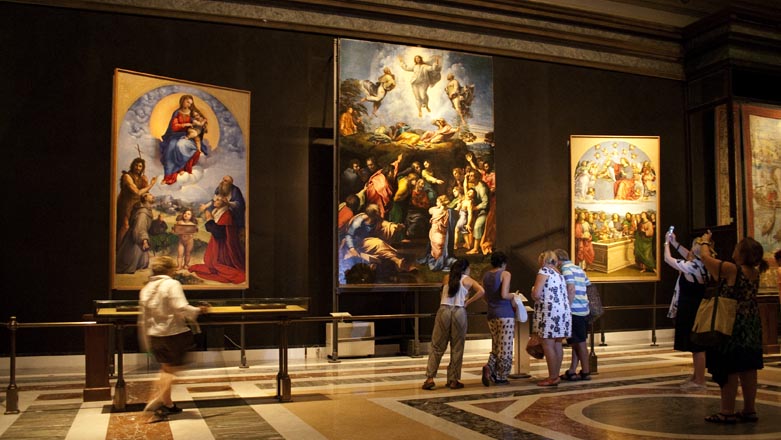
Pinacoteca Vaticana. Image source www.visiteguidate-roma.it.
WHAT TO SEE INSIDE THE VATICAN MUSEUMS: ALL THE WORKS YOU CAN’T MISS
What to see inside the Vatican Museums. Crowds of tourists visiting the Vatican Museums go directly to the Sistine Chapel, and they often avoid a detour that could make them lose some time, but that perhaps could allow them to admire calmly one of the marvels of these places: the Vatican Pinacoteca.
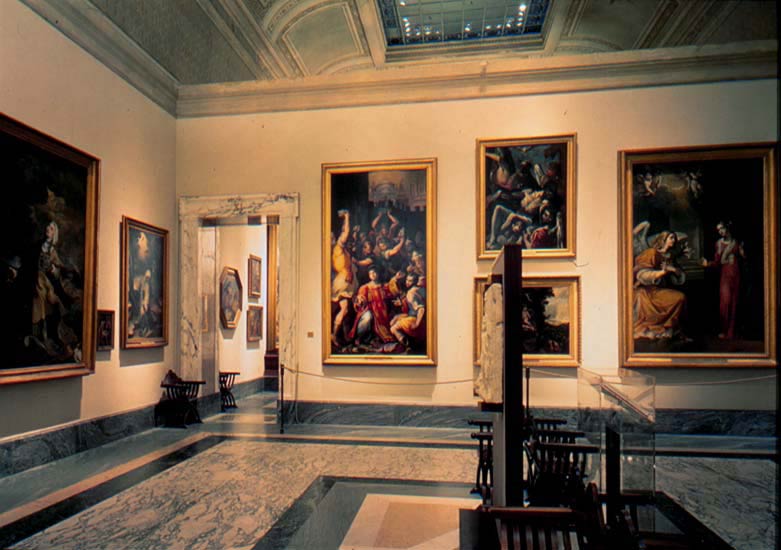
Pinacoteca Vaticana, interni. Image source bblighting.it.
Tourists might be floored by admiring in just one day all the masterpieces housed in the Vatican Museums, as I wrote in the post dedicated to the history of the Vatican Museums, where you’ll find the list of the sections you must visit.
In order not to get lost, you need some advice, and in this post I’ll give you my advice suggesting you an itinerary in pictures of the most important works of art.
Of course, the tour will finish with the spectacular view of the Sistine Chapel, the greatest masterpieces of history of art.
Tell me if you exited the Sistine Chapel with the feeling you forgot an unmissable masterpiece.
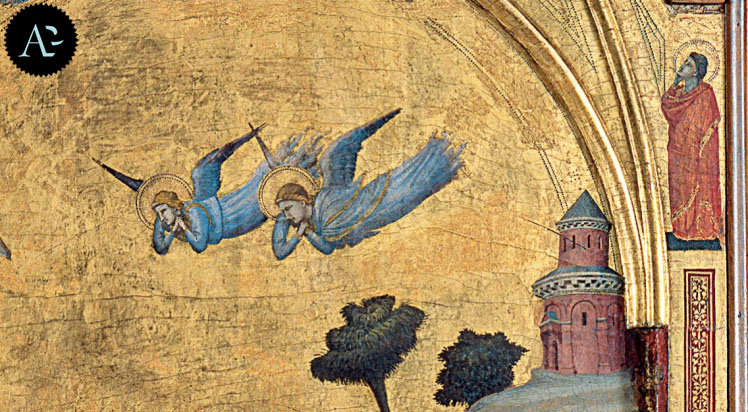
Stefaneschi Triptych
Stefaneschi Triptych
The triptych was realized by Giotto in about 1320 for the high altar of the ancient basilica of San Pietro and today it is kept inside the Vatican Pinacoteca.
It was Cardinal Jacopo Caetani degli Stefaneschi who commissioned it to the most important artist of the 14th century and is painted on both sides.
The work is particularly important because it identifies the characteristics that have made Giotto famous, which has profoundly changed Western art at the end of the Middle Ages.
Each face presents the signs of human feelings and that make Giotto’s painting so particular.
Laocoonte
The statue of Laocoon is the work that allowed the creation of the Vatican Museums.
It was found in Rome in 1506 and the best artists of the time, who were then in the city, rushed to the place of discovery to participate in the recovery operations and to study the sculpture. Among these artists there was also Michelangelo Buonarroti.
It was decided to keep it inside the Vatican and this started the reorganization of the art collections, transforming them into what are now the Vatican Museums.
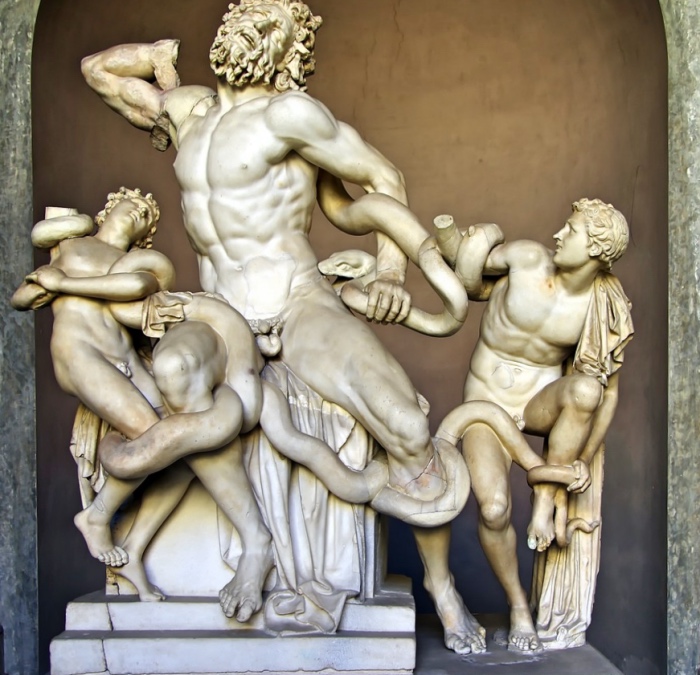
Il Laocoonte
Vatican “Stanze” or “Raphael Rooms”
The private apartments of Pope Julius II contain the frescoes by Raffaello Sanzio.
The works began in 1508 and the artist could not see them completed because it took more than sixteen years and in the meantime Raphael died.
The affreschi describe religious and philosophical ideals, becoming a model for many artists of the following ages.
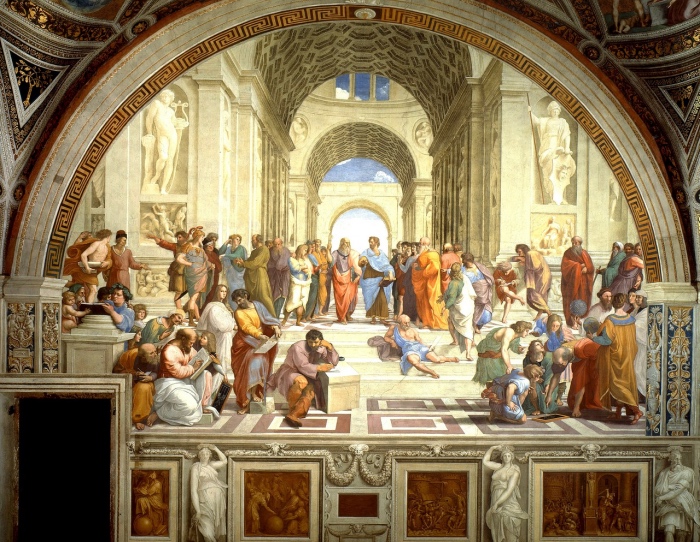
Le Stanze di Raffaello
Sistine chapel
You can not leave the Vatican Museums without having admired the Sistine Chapel.
The room in which Michelangelo’s most famous fresco is found is the place where the Pope is named and the stories taken from the book of Genesis to watch over everything, while on the main wall the Last Judgment, also a work by Michelangelo, describes the meaning and destiny of humanity.
READ ALSO – 5 things to know about Sistine Chapel and how to book tickets
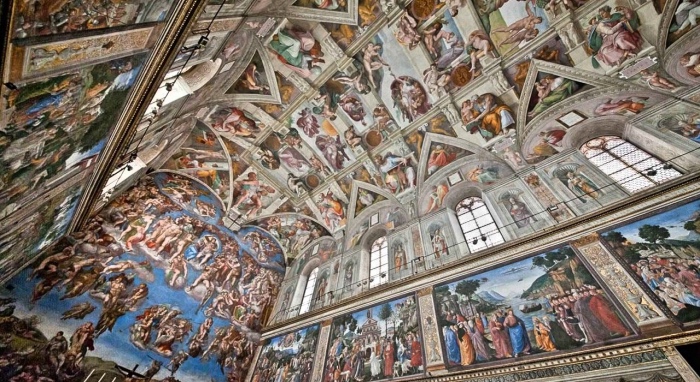
La Cappella Sistina
Momo staircase
Made in 1932 by Giuseppe Momo, the staircase of the Vatican Museums is a double spiral and consists of two staircases shaped like a double helix.
Its shape allows you to go up and down without ever meeting someone who heads in the opposite direction.
This staircase inspired Frank Lloyd Wright’s project of the Guggenheim Museum in New York.
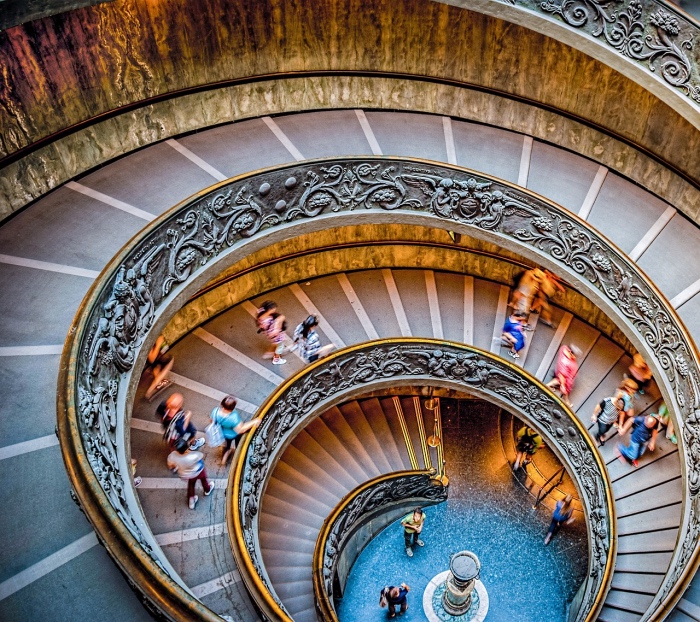
READ ALSO – Vatican Museums entrance tickets: how to skip the line


Realizzato in modo fluido e preciso, ottime le descrizioni come anche la qualità delle immagini. Sarebbe stato bello vedere molto di più, visto l’ argomento trattato, ma posso capire, anche così l’ impegno deve essere stato enorme.
Grazie Gino.
Ci saranno altri post per saperne di più su musei vaticani 🙂
Molto interessante thanks
Grazie per il tuo commento 🙂
Dello stesso alto tenore del presente post, mi piacerebbe leggere (e vedere) una selezione delle opere del Museo Pio Clementino.
Io, visitando per la terza volta i Musei Vaticani il 4 luglio c.a., ho avuto una pessima impressione.
Più che gruppi, orde di turisti con guide gridanti che invadevano tutto lo spazio fisico fra l’opera a muro ed il piccolo spazio di passaggio. Aria condizionata assente. Periodicamente visito altri Musei in Italia ed in Europa… vabbé lasciamo perdere. Comunque, grazie per questa utilissima pagina di suggerimenti. Magari ce ne fossero altre così nell’immenso web!
Al Museo Clementino spero di dedicare più che una selezione di opere. Ho in mente di visitare i Musei Vaticani nei prossimi mesi e di dedicare spazio alle varie sezioni.
Sono curiosa di vedere se troverò la situazione descritta ma sull’aria condizionata mi permetto di dire che non è fattibile in sale che conservano opere che necessitano di un tasso di umidità regolato e costante.
E’ un problema di conservazione.
Sul resto l’organizzazione può essere sempre migliorata 😉